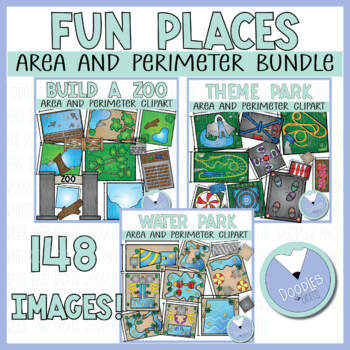Fun Places- Area and Perimeter Clip Art, Real-Life Examples
- Zip
Products in this Bundle (3)
Description
Do your upper elementary math students struggle with solving area and perimeter word problems? If so, you'll love this fun places math clipart bundle! Your third-grade or fourth-grade students can pretend to build their own water park, zoo, or theme park. These mathematical models are ideal to add to your upper elementary assessments, math discussions, and summer project-based lessons! Your elementary math students will have fun learning about the perimeter and area in a real-life setting. This math clipart can be printed out and used as hands-on manipulatives to help your students explain their thinking!
Great for:
- Showing the length and width of a rectangle.
- Finding the area and perimeter of a rectangle.
- Showing real-life connections to area and perimeter.
- Models for 3rd-grade word problems, 4th-grade word problems, and 5th-grade word problems.
- Solving for the missing length or width when given the area of a rectangle.
3 Clipart Sets in Total!
All images are saved as PNG formats (300 PPI) with transparent backgrounds.
Sets INCLUDE:
- Water Park Area/Perimeter Clipart
- Build a Zoo Area/Perimeter Clipart
- Theme Park Area/Perimeter Clipart
All images come with brackets and have a version without brackets to allow layering!
TERMS OF USE
Please read my Terms of Use for more information about personal and commercial use of these graphics prior to purchasing.
EXTENDED LICENSE FOR DIGITAL PRODUCTS
If you are interested in creating digital products with moveable graphics, you must purchase an extended license. For more information on digital products, please see my Full Terms of Use. You may use these in Boom Cards, Seesaw, and TPT Easel WITHOUT the extended license since those platforms protect the digital graphics! Have any questions? Email me at contact@doodleslearning.com.
ZIP FILES
You will receive these images in a zip file. Click HERE for helpful tips to download and access zip files.
Like this area and perimeter clipart? Check out my other area and perimeter clipart!
Let’s Connect!
Check out our Website for more resources
Follow Doodles and Digits on Instagram
Follow Doodles and Digits on Facebook
© Doodles and Digits LLC 2022.


